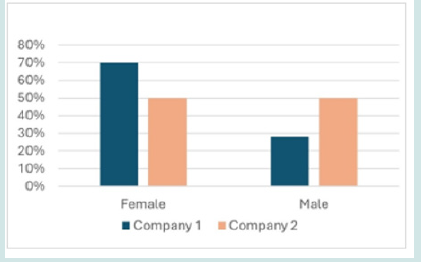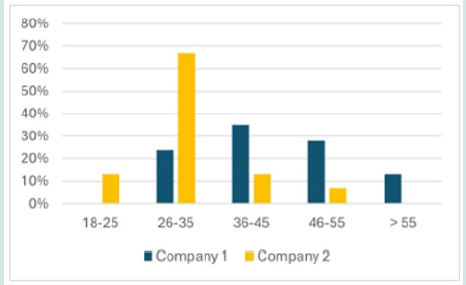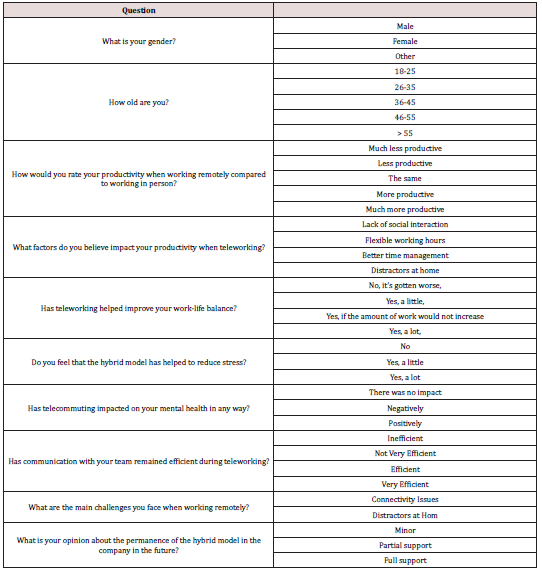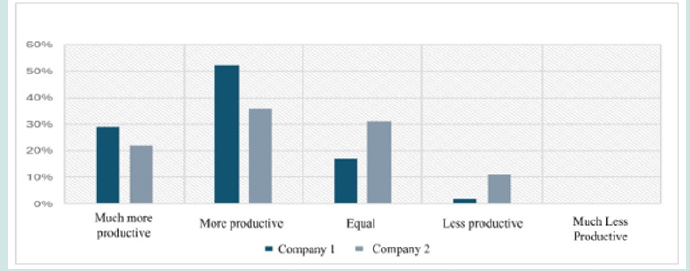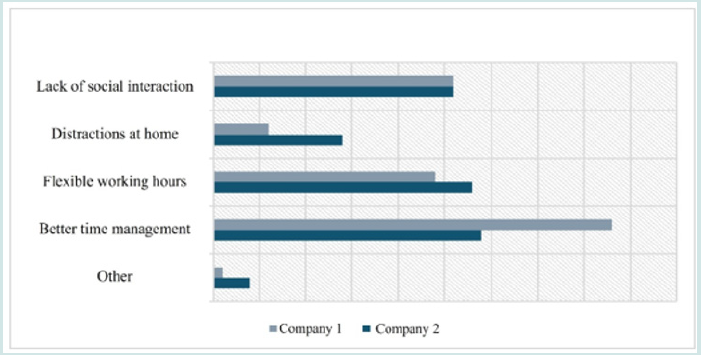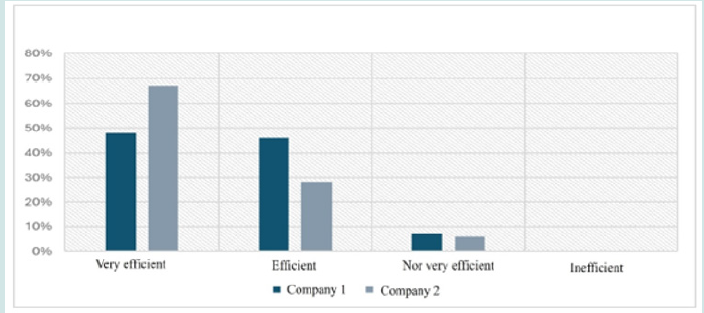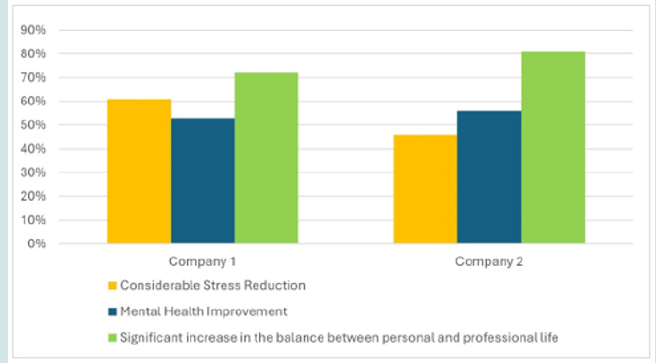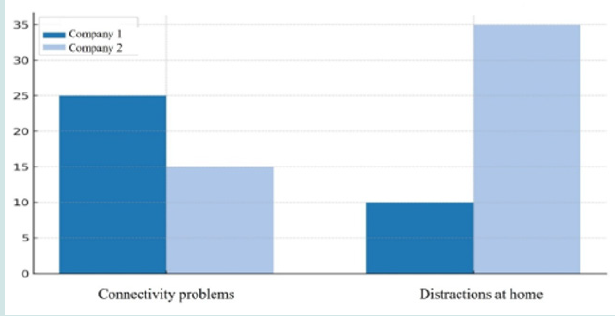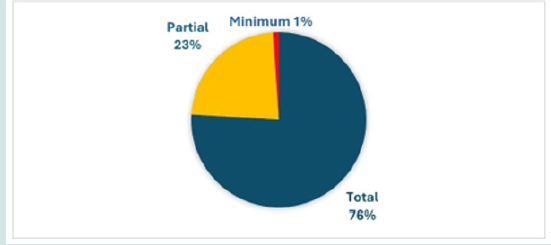
Lupine Publishers Group
Lupine Publishers
Menu
ISSN: 2641-1768
Research ArticleOpen Access
The Impact of Teleworking on Productivity, Communication and Job Satisfaction Volume 8 - Issue 4
Carla Narciso, Joana Parreira, Nicole Graça, Victória Omelyanenko and Ana Palma-Moreira*
- European University of Lisbon, Portugal
Received: March 18, 2025; Published: March 25, 2025
Corresponding author: Ana Palma-Moreira, Faculdade de Ciências Sociais e Tecnologia, Universidade Europeia, Quinta do Bom Nome, Estr. da Correia 53, 1500-210 Lisboa, Portugal.
DOI: 10.32474/SJPBS.2025.08.000295
Abstract
This study aimed to study the impact of teleworking on productivity, organizational communication and employee satisfaction. One hundred participants working in two organizations in Portugal participated in this study. This study aims to provide a more in-depth understanding of the impact of teleworking, which aligns with the expectations for improvements in the management of this model in the organizations discussed above. The hybrid model stood out as the preferred solution, balancing the advantages of remote working with the benefits of face-to-face interaction. This balance highlights the importance of a flexible approach that considers both the needs of employees and the organization’s requirements.
Keywords: Teleworking, Productivity, Organizational Communication, Job Satisfaction
Research Article
Remote working, or teleworking, and the term “Home Office” has been on the rise in companies and have become quite common in recent years, especially during and after the pandemic (COVID-19), which caused this practice to gain momentum worldwide. In addition to the benefits of this working model, there are still doubts about its impact on companies’ productivity. Teleworking can take various forms, including informal work or mixed/hybrid teleworking (which is when the company agrees with employees that they will be at the workplace for a few hours or days a week and the rest in the home office) [1] 100% home office work (when working hours are completely remote) [2]. There is a widespread perception that the absence of physical interaction and social isolation can harm the efficiency and performance of employees, as it makes it difficult to separate work and personal life, and consequently also hinders communication and teamwork. Companies face doubts about the effectiveness of teleworking, especially in contexts that require intensive collaboration. Studies suggest that while remote working can reduce costs and improve employees’ quality of life, it also presents challenges, such as social isolation and difficulty establishing boundaries between work and personal life. Understanding these impacts is crucial if companies decide to adopt this model. We chose this topic for our research because many companies are still reluctant to adopt this method or want to return to the traditional face-to-face working model. We also want to provide a more in-depth analysis of the effectiveness of remote working as an alternative for companies to adopt.
Through this research, we will objectively determine whether there is a loss of productivity or an increase in efficiency. We will also explore other variables that influence productivity in this context of teleworking, such as the reduction of operating costs, the use and discovery of new applications or digital tools, time management, employee satisfaction with this working method and the fact that they enjoy more time for personal life and leisure since there is no need to spend time commuting from home to work and vice versa.
The following research question is therefore formulated:
Does teleworking affect productivity, communication and employee satisfaction in companies?
This study aims to analyze the impact of teleworking on productivity, organizational communication and employee satisfaction.
Methods
Procedure
The study involved 46 employees from Company 1 in the energy sector in Portugal and 54 employees from Company 2 in the Data Analytics and Artificial Intelligence area. The final sample was intended to cover approximately 100 participants who had adopted teleworking at their companies’ request. The questionnaire was written by the authors of this manuscript and uploaded to Google Forms. The statistical analysis was carried out using Microsoft Excel. Frequency tables were drawn up, which in turn gave rise to the vertical, horizontal, and circular graphs presented throughout this research. This phase allowed us to determine the quality of the data, its perceptibility, and trends.
Participants
Based on the universal sample taken, it can be seen that 78% of respondents are female, and the remaining 22% are male (Figure 1).
The age range is between 26-35 years (Figure 2).
Instrument
The authors constructed the questionnaire uploaded to the Google Forms platform for this study, which is shown in Table 1.
Result and Discussion
The impact of teleworking on productivity
Company 1 shows greater acceptance and better results in terms of teleworking productivity. This may indicate that the company has better management practices, suitable tools, or even a better adapted culture to this model (Figure 3). Although Company 2 has a considerable number of employees who find teleworking productive, it faces more stability and falling productivity challenges. This could mean it needs to innovate and/or improve processes (Figure 3).
Factors that influence productivity
Figure 4 shows that employees at Company 1 manage their time better under this system. On the other hand, employees at Company 2 value both time management and flexible working hours. The lack of social interaction is a common concern, demonstrating the importance of implementing strategies promoting communication and interaction in the teleworking environment (Figure 4).
Figures 3 & 4 highlight different aspects related to teleworking productivity, corroborating studies by Filardi et al. [3], Fiolhais [4], the International Labor Organization [ILO] [5]. Graph 3 shows that productivity is perceived more positively in Company 1, suggesting more efficient management practices, appropriate tools, and an organizational culture better adapted to teleworking. Graph 4 shows factors such as time management and flexible working hours as the main drivers of productivity in both companies, although the lack of social interaction remains a significant challenge. These results reflect the trends in literature, which emphasize the importance of support structures, effective communication, and good practices in maximizing the benefits of teleworking on organizational productivity.
Efficiency in communication
According to Figure 5, which analyzes communication efficiency, although both companies have positive perceptions of efficiency, Company 2 has a higher percentage of employees who consider it “Very Efficient” (Figure 5). The fact that there is no inefficiency shows that there is positive individual performance in communication. These high levels of efficiency are also a reflection of the tools provided by the company, namely Microsoft Teams and Email.
It is possible to observe that communication in teleworking is widely perceived as efficient, emphasizing the positive performance of the organization’s technological tools. However, the ideas defended by [6] present a counterpoint to our defense, emphasizing that communication efficiency should be technical and relational, as shown in Graph 4. These authors stress that trust in teleworkers is fundamental, allowing for greater flexibility, proactivity and adaptability to change, and that communication should be focused on coordination rather than control. Thus, although the study highlights positive results, it can be questioned whether communication efficiency adequately promotes a more flexible and innovative dynamic in teleworking.
Habits and Work Practices
Figure 6 compares the positive impacts of teleworking in two companies in three key dimensions: a considerable reduction in stress, improved mental health and a significant increase in worklife balance. Company 1 has a more significant impact on reducing stress, while Company 2 stands out for improving mental health and work-life balance. This aligns with the advantages of teleworking identified by Baruch (2001).
Figure 6 highlights the positive impacts of teleworking, such as reducing stress, improving mental health and increasing worklife balance, which can be related to the analysis of (Placeholder1) (Mar12). These authors point out that flexibility in the workplace, a defining characteristic of teleworking, is positively associated with company and employee performance. However, they also warn of the potential increase in workload and demands on teleworkers, which can result in overload. This graph demonstrates that although teleworking clearly benefits employee well-being, such as a significant reduction in stress and improved mental health, it is crucial to manage this flexibility carefully to avoid it becoming overloaded. Thus, the positive relationship between flexibility and performance will only be sustainable if practices are adopted that balance the advantages of autonomy while preventing possible excesses, as the authors warn.
Challenges in teleworking
In Figure 7, regarding the challenges of teleworking, we can see that in Company 1, we highlight connectivity problems, such as technical difficulties, low internet speed or even connection failures that affect productivity. On the other hand, in Company 2, we saw an increase in distractions in the home environment, which is also a challenge in teleworking because interruptions can lead to reduced concentration and have a negative impact on productivity and job performance.
Bailey and Kurland argue that factors such as technological limitations and difficulties concentrating in the home environment are common in this work model, reinforcing the need for adequate support in terms of infrastructure and management. Figure 7 corroborates this perspective, showing that overcoming these challenges requires investments in technology, creating more organized work environments and ongoing support for teleworkers to mitigate negative impacts and maximize productivity.
Preference for the Hybrid Model
Data analysis, as shown in Figure 8, reveals that regardless of the respondent’s age group and gender, there is an increasing tendency to prefer the hybrid model, while a lower percentage shows partial agreement. This preference, however, contrasts with the view presented by Sánchez, Pérez-Pérez, Carnicer and Jiménez and Vega, Anderson and Kaplan, who defend full teleworking as an ideal solution. These authors argue that 100% teleworking allows for greater autonomy, flexibility, and cost savings for employees and companies, promoting a more effective work-life balance. However, the data shown in Figure 8 suggests that, despite the advantages of teleworking, many employees still value some level of face-to-face interaction, indicating that the hybrid model can be seen as a more balanced and inclusive solution. This difference highlights the need to adapt working models to employees’ needs and preferences, considering both the advantages the authors advocated, and the practical perceptions expressed in the study. There is a clear tendency to combine the advantages of teleworking with the benefits of face-to-face interaction. This preference aligns with the views presented by authors such as Hill, Ferris and Märtinson [7] and Golden, Veiga and Dino [8], who defend the mixed model as an ideal solution to meet the needs of companies and employees.
These authors argue that the hybrid model offers the best of both worlds, allowing greater flexibility and autonomy provided by teleworking while maintaining the face-to-face interaction needed to strengthen the organizational culture, facilitate collaboration and reduce the feeling of isolation. The data in Figure 8 reinforces this view, showing that employees widely prefer the mixed model, as it balances productivity and well-being, responding to both the demands of remote work and the social and professional needs of face-to-face work. The results corroborate the literature, which identifies improved work-life balance as one of the main benefits of teleworking. Adapting to social, administrative, and technological changes is one of the biggest challenges facing companies. Therefore, it is necessary to look for practical solutions so that this teleworking system is efficient for both organizations and employees.
Limitations
It is important to note that although the data obtained in this research allows for a relevant qualitative analysis, it has limitations, especially concerning the sample’s representativeness. Thus, the results should be interpreted cautiously and not generalized, given that the sample does not adequately reflect reality [9-12]. It is recommended that future studies continue to explore the impact of teleworking, covering other organizations to enable comparisons.
Conclusion
This study on the impacts of teleworking revealed significant results that align with the existing literature. Improvements in worklife balance, increased productivity, and communication efficiency were identified as some of the main benefits associated with this working model. However, the challenges related to connectivity, distractions in the home environment, and the lack of social interaction demonstrate the need for effective strategies to mitigate these limitations. Although the qualitative and quantitative analysis provided valuable insights, the sample’s representativeness is a significant limitation, restricting the possibility of generalizing the results. Therefore, future studies should explore the impact of teleworking on a larger scale, covering different sectors and organizational contexts, allowing for a more comprehensive comparative analysis. The hybrid model stood out as the preferred solution, balancing the advantages of remote working with the benefits of face-to-face interaction. This balance highlights the importance of a flexible approach that considers both the needs of employees and the organization’s requirements. Implementing pilot projects in the public or private sector can serve as a reference for the dissemination of good practices, promoting the effectiveness and well-being of workers in the context of teleworking. Finally, this study reinforces the importance of teleworking as a strategic tool for the future of organizations.
Conflict of Interest
No conflict of interest.
Acknowledgement
None.
Research Article
- Rosenfield C, Alves D (2011) Autonomy and Information Work: Telework. Journal of Social Sciences, 54(1): 207-233.
- Moneris (2024) Valuing Human Potential.
- Filardi F, Castro R, Zanini M (2020) Advantages and disadvantages of teleworking in public administration: Analysis of the experiences of Serpro and the Federal Revenue Service. EBAPE.BR Notebooks, 18(1): 28–46.
- Fiolhais R (2007) Telework and human resource management. In: Caetano A, J Vala (Orgs.): Human resource management: Contexts, processes and techniques (3ª ed, pp. 235–262) Editora RH.
- International Labour Organization (2013) Advantages of remote work. ILO – Docs. Available.
- Barros A, Silva J (2010) Individuals’ perceptions of the consequences of teleworking in the home-office configuration: Case study at Shell Brazil. EBAPE Notebooks, 8(1): 71–91.
- Hill EJ, Ferris M, Märtinson V (2003) Does it matter where you work? A comparison of how three work locations influence aspects of work and personal/family life. Journal of Vocational Behavior, 63(2): 220–241.
- Golden TD, Veiga JF, Dino RN (2008) The impact of superior-subordinate relationships on the commitment, job satisfaction, and performance of telecommuters. Journal of Vocational Behavior, 72(2): 212–225.
- Quivy R, Campenhoudt LV (1998) Handbook of research in social sciences (2nd ed.) Gradiva.
- Gajendran R, Harrison D (2007) The good, the bad, and the unknown about telecommuting: Meta-analysis of psychological mediators and individual consequences. Journal of Applied Psychology, 92(6): 1524–1541.
- Martin B, MacDonnell R (2012) Is teleworked effective for organizations? A meta-analysis of empirical research on perceptions of telework and organizational outcomes. Management Research Review, 35(7): 602–616.
- Raghuram S, Wiesenfield B, Garud R (2003) Technology enabled work: The role of self-efficacy in determining telecommuter adjustment and structuring behavior. Journal of Vocational Behavior, 63(2): 180–198.

Top Editors
-

Mark E Smith
Bio chemistry
University of Texas Medical Branch, USA -

Lawrence A Presley
Department of Criminal Justice
Liberty University, USA -

Thomas W Miller
Department of Psychiatry
University of Kentucky, USA -

Gjumrakch Aliev
Department of Medicine
Gally International Biomedical Research & Consulting LLC, USA -

Christopher Bryant
Department of Urbanisation and Agricultural
Montreal university, USA -

Robert William Frare
Oral & Maxillofacial Pathology
New York University, USA -

Rudolph Modesto Navari
Gastroenterology and Hepatology
University of Alabama, UK -

Andrew Hague
Department of Medicine
Universities of Bradford, UK -

George Gregory Buttigieg
Maltese College of Obstetrics and Gynaecology, Europe -

Chen-Hsiung Yeh
Oncology
Circulogene Theranostics, England -
.png)
Emilio Bucio-Carrillo
Radiation Chemistry
National University of Mexico, USA -
.jpg)
Casey J Grenier
Analytical Chemistry
Wentworth Institute of Technology, USA -
Hany Atalah
Minimally Invasive Surgery
Mercer University school of Medicine, USA -

Abu-Hussein Muhamad
Pediatric Dentistry
University of Athens , Greece

The annual scholar awards from Lupine Publishers honor a selected number Read More...




